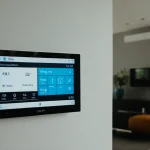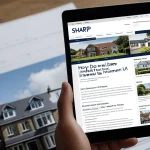Overview of Innovative Home Styles in the UK
Innovative home design in the UK is evolving rapidly, blending functionality with style to meet contemporary needs. In 2024, UK home style trends emphasize sustainability, versatility, and technology integration without compromising aesthetic appeal. Among the key features shaping these trends is the increased adoption of open-plan spaces that encourage fluid living, alongside creative storage solutions tailored to smaller urban dwellings.
Culture, climate, and local architecture heavily influence these trends. For example, coastal areas favor weather-resistant materials and breezy interiors, while city homes often showcase sleek, minimalist finishes that reflect modern metropolitan life. The British love for period details is maintained but reinterpreted with modern touches, creating a dialogue between tradition and innovation.
Also read : Will Home Automation Transform Your Daily Routine in the UK?
Homeowners are increasingly attracted to innovations such as smart energy-efficient installations, multifunctional furniture, and natural materials that promote wellness. These choices echo a growing desire for homes that adapt to varied lifestyles, bringing together practicality and comfort. This fusion firmly places trending UK interiors at the forefront of global design movements, setting standards for innovative home designs that are both inspiring and practical.
Architectural Trends Defining Modern UK Homes
Modern UK architecture trends skilfully blend tradition with innovation, redefining how we experience our living spaces. A standout feature is the reinterpretation of classic British structures—think Georgian and Victorian facades updated with sleek, contemporary materials. This fusion preserves heritage while introducing modern aesthetics that appeal to today’s homeowners.
Also read : How Can Home Design Transform Your Daily Life in the UK?
Open-plan layouts dominate contemporary UK homes. They create flexible living spaces that cater to evolving lifestyles, supporting activities from remote work to family gatherings. Such layouts encourage fluid movement and maximize usability in often compact urban environments.
Natural light plays a pivotal role in these architectural trends. Incorporating skylights, glass extensions, and floor-to-ceiling windows enhances brightness and connects indoors with outdoor surroundings. This emphasis on light not only improves ambiance but also supports wellbeing, reducing dependence on artificial lighting.
These architectural evolutions echo broader UK home style trends by balancing functionality, style, and a connection to history. The result is elegant yet practical spaces that feel both timeless and refreshingly modern—ideal for those seeking a home that adapts to daily needs and reflects cultural identity.
Interior Design Elements Influencing UK Trends
In UK interior design trends, the fusion of bold colours and varied textures is reshaping how spaces feel and function. Homeowners increasingly embrace biophilic design, which integrates natural elements like plants and organic materials to enhance wellbeing and connect interiors with the outdoors. This approach not only freshens rooms but also supports mental health, answering why it is a leading trend in trending décor.
Statement furniture plays a vital role in these interiors. Rather than simply filling space, pieces serve dual purposes—combining aesthetics with practicality. Multi-functional furniture supports flexible living, accommodating work, leisure, or family time within the same room.
Vintage revival remains strong, reflecting a desire for bespoke craftsmanship and timeless character. British aesthetics are evident in the blending of new and old, where handcrafted details and period-inspired accents coexist with contemporary finishes. This mix contributes uniquely to trending UK interiors, offering originality and cultural resonance that buyers and designers seek alike.
Embracing Sustainability in UK Home Design
Sustainability is a cornerstone of innovative home design within the UK, reflecting growing environmental awareness in UK home style trends. A key feature shaping modern homes is the adoption of eco-friendly materials like reclaimed wood, bamboo, and recycled metals. These materials reduce resource consumption while adding unique textures and warmth to interiors.
Energy efficiency is central to green UK interiors. Techniques such as high-performance insulation, triple-glazed windows, and solar panels optimize thermal comfort and reduce utility bills. These elements respond both to climate considerations and a long-term commitment to lowering carbon footprints.
Homeowners increasingly seek designs that promote sustainability without sacrificing style. For example, rainwater harvesting systems and green roofs blend functionality with visual appeal, promoting water conservation and biodiversity.
The trend toward sustainable home styles UK-wide also includes innovative construction methods like modular building, which minimizes waste and accelerates timelines. This fusion of environmental responsibility and practicality positions sustainability as a defining factor in trending UK interiors, offering healthier living environments and future-proof property value.
Smart Home Technology Adoption in the UK
Smart home technology adoption is a defining feature of UK smart homes in 2024, driving a transformation in how residents interact with their living environments. Home automation trends focus on integrating AI-powered home systems that manage lighting, heating, security, and even appliances. These systems learn user habits to optimize energy use while enhancing comfort and convenience.
Popular smart devices include intelligent thermostats, motion-activated lighting, and advanced security cameras. Such technologies not only improve safety but also support energy management by reducing waste—important for homeowners seeking both sustainability and cost savings. The seamless connectivity across devices facilitates remote control via smartphones, empowering users to monitor and adjust their homes from anywhere.
The influence of technology extends into tech-enabled interiors, where smart elements blend with modern design without sacrificing style. This integration increases property value and appeals to buyers prioritizing innovation and efficiency. Overall, smart home adoption reflects a pivotal shift in UK home style trends, where convenience merges with cutting-edge technology to create adaptable, future-ready living spaces.
Distinctive UK Influences Shaping Trend Direction
UK lifestyle trends shape home styles through a dynamic balance of tradition and modernity. British home style influences are evident in the way designers reinterpret classic architectural details—such as sash windows or wrought iron balconies—while incorporating contemporary finishes. This creates homes that respect heritage yet feel current and functional.
Regional design features vary notably between urban and rural areas. Urban homes often embrace minimalist interiors and space-saving solutions, reflecting the demands of city living. In contrast, rural properties lean into rustic materials like stone and timber, preserving a connection to the natural environment and local craftsmanship.
The fusion of traditional elements with modern innovations is a hallmark of UK home style trends. For example, exposed brick walls can coexist with sleek kitchen cabinetry, illustrating how historic textures merge with trending UK interiors. Such combinations support diverse lifestyles and preferences across Britain.
Understanding these distinctive influences helps homeowners and designers tailor spaces that resonate culturally and practically. This regional sensitivity is key to innovative home design’s success across the UK, blending heritage, climate considerations, and evolving lifestyle needs into cohesive, distinctive homes.
Overview of Innovative Home Styles in the UK
UK home style trends in 2024 emphasize a seamless blend of innovative home design with cultural and environmental responsiveness. A defining feature is the adaptation to regional climate and local architecture, which shapes material choices and spatial arrangements. Coastal homes prioritize weather-resistant finishes and breezy interiors, while urban residences favour minimalist designs that maximize use of limited space.
Homeowners gravitate toward innovations that enhance daily living. This includes incorporating smart, energy-efficient systems alongside multifunctional furniture that suits evolving lifestyles. Trending UK interiors celebrate natural materials such as bamboo and reclaimed wood, fostering wellness and sustainability.
Flexibility is key in these designs. Open-plan spaces and creative storage accommodate the demands of modern living without sacrificing comfort or aesthetic appeal. This approach supports the increasing desire for homes that are adaptable, sustainable, and stylish.
Ultimately, the most popular innovations reflect a commitment to blending practicality with beauty, ensuring that homes are not only visually appealing but also responsive to the needs of contemporary British lifestyles and environmental concerns.


